Visit to the Taipei Feitsui ReservoirDate: 2025-07-23
Section: Exchanges | 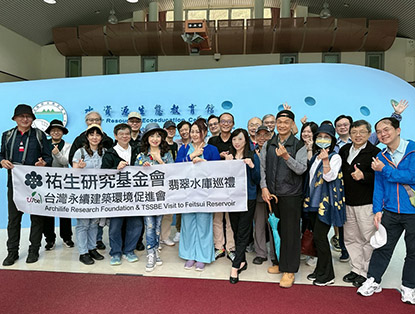 祐生長期關注氣候異變與其對人類社會可能造成的影響與衝擊,並持續透過長年培養的人才在各自的崗位上朝上述目標貢獻一己之力。是以在時任台北翡翠水庫管理局局長林裕益先生的盛情邀請下,特別協同社團法人台灣永續建築環境促進會一起安排「台北翡翠水庫巡禮」活動,讓祐生成員們有機會一睹台北翡翠水庫的風貌。 祐生長期關注氣候異變與其對人類社會可能造成的影響與衝擊,並持續透過長年培養的人才在各自的崗位上朝上述目標貢獻一己之力。是以在時任台北翡翠水庫管理局局長林裕益先生的盛情邀請下,特別協同社團法人台灣永續建築環境促進會一起安排「台北翡翠水庫巡禮」活動,讓祐生成員們有機會一睹台北翡翠水庫的風貌。
Archilife has long been committed to addressing the challenges of climate change and its potential impacts on human society. Over the years, it has pursued this mission by cultivating members who contribute in their respective fields. In this spirit, and at the gracious invitation of Mr. Lin Yu-yi, the Director-General of the Taipei Feitsui Reservoir Administration, Archilife partnered with the Taiwan Society of Sustainable Built Environment(TSSBE) to organize a “Visit to the Taipei Feitsui Reservoir.” This special event offered Archilife members a rare opportunity to experience firsthand the distinctive landscape of the Taipei Feitsui Reservoir.
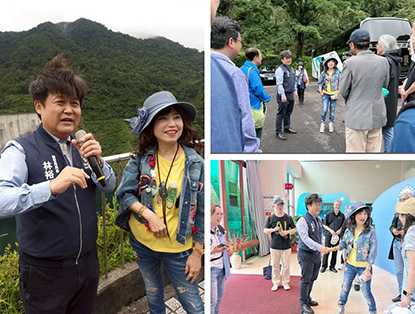 2025年6月4日一早,在本會黃晉英秘書長及社團法人台灣永續建築環境促進會陳泰安理事長的等候中,所有參加成員準時搭車出發前往台北翡翠水庫。抵達後由林裕益局長接待並親自向大家導覽台北翡翠水庫。林局長很開心地表示,台北翡翠水庫雖然不是全台蓄水量最大的水庫,但卻是蓄水量平均維持最佳狀態的冠軍水庫。自1987年正式啟用以來,翡翠水庫扮演著台北市與新北市近400萬人口供水的中樞角色,不僅保障都市生活的穩定與安全,更成為集水資源管理、生態保育與環境教育於一身的多功能水庫。其名稱「翡翠」,既象徵水庫清澈如玉的水質,也反映出它對大台北地區不可取代的價值。 2025年6月4日一早,在本會黃晉英秘書長及社團法人台灣永續建築環境促進會陳泰安理事長的等候中,所有參加成員準時搭車出發前往台北翡翠水庫。抵達後由林裕益局長接待並親自向大家導覽台北翡翠水庫。林局長很開心地表示,台北翡翠水庫雖然不是全台蓄水量最大的水庫,但卻是蓄水量平均維持最佳狀態的冠軍水庫。自1987年正式啟用以來,翡翠水庫扮演著台北市與新北市近400萬人口供水的中樞角色,不僅保障都市生活的穩定與安全,更成為集水資源管理、生態保育與環境教育於一身的多功能水庫。其名稱「翡翠」,既象徵水庫清澈如玉的水質,也反映出它對大台北地區不可取代的價值。
On the morning of June 4, 2025, Secretary General Huang Chin-ying and Chairman of TSSBE Chen Tai-an, together with all participating members, departed on schedule for a visit to the Taipei Feitsui Reservoir. Upon arrival, they were warmly received by Director-General Lin Yu-yi, who personally guided the group on a visit to the reservoir. With evident pride, Director-General Lin noted that while the Taipei Feitsui Reservoir is not the largest reservoir in Taiwan by storage capacity, it consistently maintains the most stable average storage levels, earning it the title of Taiwan’s “champion reservoir.” Since its official commissioning in 1987, the reservoir has played a pivotal role in supplying water to nearly four million residents of Taipei City and New Taipei City. Beyond safeguarding the stability and security of urban life, it also functions as a multi-purpose reservoir, integrating water resource management, ecological conservation, and environmental education. Its name, “Feitsui,” symbolizes both the jade-like clarity of its waters and its unparalleled importance to the Greater Taipei region.
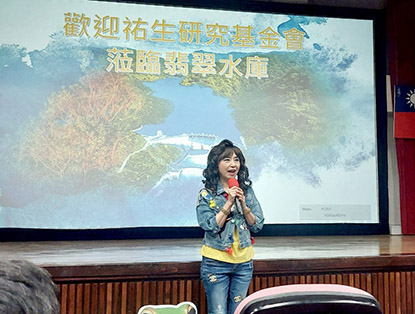 除了實質的供水與生態功能,翡翠水庫亦發展出豐富的環境教育資源。台北自來水事業處在水庫附近設有「翡翠水庫生態教育館」,定期舉辦導覽解說、工作坊與水資源教育課程,向民眾與學校團體傳遞水資源保育與環境永續的概念。透過結合現地體驗、科學教育與社區參與,翡翠水庫不僅讓人理解水從哪裡來、如何被淨化,也讓更多人意識到用水的珍貴與背後的複雜管理機制。這種深具啟發性的學習方式,不僅提升了公眾的環保意識,也為下一代的永續發展奠定基礎。 除了實質的供水與生態功能,翡翠水庫亦發展出豐富的環境教育資源。台北自來水事業處在水庫附近設有「翡翠水庫生態教育館」,定期舉辦導覽解說、工作坊與水資源教育課程,向民眾與學校團體傳遞水資源保育與環境永續的概念。透過結合現地體驗、科學教育與社區參與,翡翠水庫不僅讓人理解水從哪裡來、如何被淨化,也讓更多人意識到用水的珍貴與背後的複雜管理機制。這種深具啟發性的學習方式,不僅提升了公眾的環保意識,也為下一代的永續發展奠定基礎。
Aside from the actual water supply and ecological feature, the Feitsui Reservoir generates an abundance of environmental education resources. The Taipei Water Department established the “Feitsui Reservoir Ecological Education Center” and regularly hosts guided tours, workshops, and water resource education programs for the public and school groups, promoting the concepts of water conservation and environmental sustainability. Through on-site experiences, scientific education, and community participation, the Feitsui Reservoir not only enables individuals to understand where water comes from and how it is purified, but it also raises awareness about water consumption and the underlying complex management mechanisms. This inspiring approach to learning enhances public environmental consciousness and helps lay a strong foundation for sustainable development for future generations.
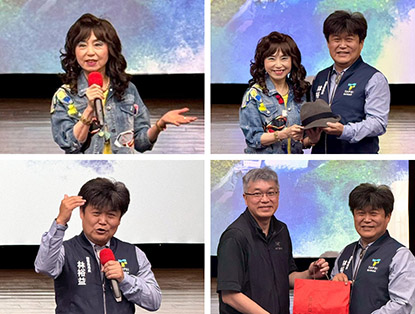 其間,黃秘書長特別致辭感謝林局長百忙之中的熱情接待並提醒本次參訪的重點。在林局長深入淺出的彙報以及觀看管理局的影片後,黃秘書長與陳理事長也致贈禮品聊表謝意,而林局長則回贈代表翡翠水庫保育成果的黑鳶繩帶領帶。一行人隨後跟隨林局長的腳步參觀大壩口等,近距離體驗並感受水庫的大與美,當然也不免俗地留下許多令人回味無窮的照片。一行人開開心心地在林局長的全程陪同暨導覽下完成台北翡翠水庫巡禮活動。 其間,黃秘書長特別致辭感謝林局長百忙之中的熱情接待並提醒本次參訪的重點。在林局長深入淺出的彙報以及觀看管理局的影片後,黃秘書長與陳理事長也致贈禮品聊表謝意,而林局長則回贈代表翡翠水庫保育成果的黑鳶繩帶領帶。一行人隨後跟隨林局長的腳步參觀大壩口等,近距離體驗並感受水庫的大與美,當然也不免俗地留下許多令人回味無窮的照片。一行人開開心心地在林局長的全程陪同暨導覽下完成台北翡翠水庫巡禮活動。
During the visit, Secretary General Huang especially expressed her heartfelt gratitude to Director-General Lin for his gracious hospitality despite his busy schedule and gave a reminder of the visit’s highlights. She also took the opportunity to commend Archilife members for their dedication and hard work in their respective roles. After listening to Director-General Lin’s clear and insightful briefing and watching an introductory video, Secretary General Huang and Chairman Chen presented gifts as tokens of appreciation. In return, Director-General Lin presented the Black Kite–themed bolo ties, symbolizing the reservoir’s conservation achievements. The visiting delegation then accompanied Director-General Lin to the dam and other key sites, experiencing firsthand the scale and beauty of the reservoir. Naturally, many memorable photos were taken. With Director-General Lin’s full accompaniment and guidance, the group concluded a rewarding and unforgettable visit to the Taipei Feitsui Reservoir.
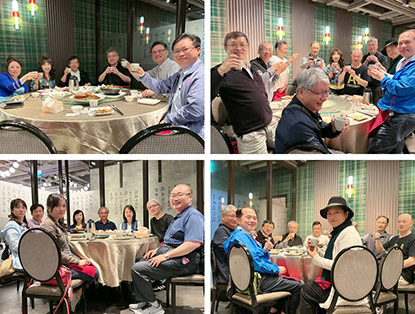 隨後,為了幫一個上午聚精會神聆聽簡報及走訪台北翡翠水庫的一行人補充體能,黃秘書長特別在蘇杭餐廳設宴,席間並親切地與大家閒話家常,當天行程就在身心都獲得滿足後圓滿劃下句點。 隨後,為了幫一個上午聚精會神聆聽簡報及走訪台北翡翠水庫的一行人補充體能,黃秘書長特別在蘇杭餐廳設宴,席間並親切地與大家閒話家常,當天行程就在身心都獲得滿足後圓滿劃下句點。
To replenish the energy of the group after a morning of briefings and visiting the Taipei Feitsui Reservoir, Secretary General Huang graciously hosted a luncheon at Su Hung Restaurant. Over the meal, she engaged in warm and casual conversation with the participants, bringing the day’s itinerary to a close on a satisfying note, with everyone feeling both refreshed and fulfilled.
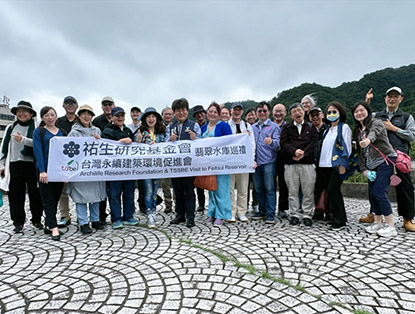 藉由此次台北翡翠水庫巡禮,大家充分理解到翡翠水庫的重要性,它不只是供水設施,更是防災減災、氣候調適的關鍵基礎建設,是一座融合水資源管理、生態保育、環境教育與地方發展的綜合性典範。在面臨全球水資源危機與生態退化的關頭,翡翠水庫的經驗恰恰提供了一個難得的永續典範,提醒我們:守護一滴水,就是守護一座城市的未來。未來,隨著極端氣候風險上升,如何持續維護其功能與生態環境,也將成為未來重要課題。 藉由此次台北翡翠水庫巡禮,大家充分理解到翡翠水庫的重要性,它不只是供水設施,更是防災減災、氣候調適的關鍵基礎建設,是一座融合水資源管理、生態保育、環境教育與地方發展的綜合性典範。在面臨全球水資源危機與生態退化的關頭,翡翠水庫的經驗恰恰提供了一個難得的永續典範,提醒我們:守護一滴水,就是守護一座城市的未來。未來,隨著極端氣候風險上升,如何持續維護其功能與生態環境,也將成為未來重要課題。
This visit to the Taipei Feitsui Reservoir offered participants a deeper appreciation of its vital importance. In addition to serving as a water supply facility, it is a critical infrastructure for disaster prevention, disaster mitigation, and climate adaptation. It also represents a holistic model that integrates water resource management, ecological conservation, environmental education, and community development. At a time of global water scarcity and ecological degradation, the Taipei Feitsui Reservoir’s experience serves as a rare sustainability model. It reminds us that safeguarding every drop of water is, in essence, safeguarding the future of an entire city. Looking ahead, as the risks of extreme climate events continue to rise, maintaining both the reservoir’s functions and its ecological integrity will remain a critical challenge.
|
|